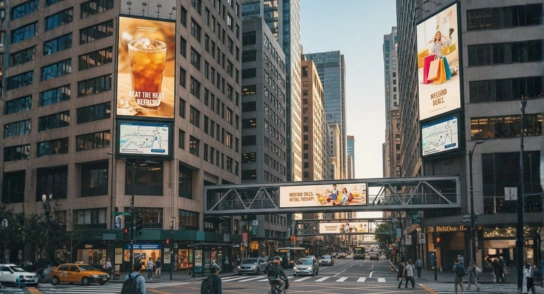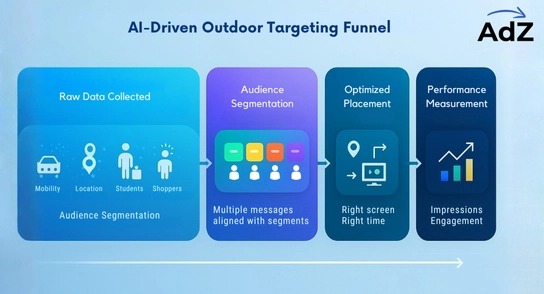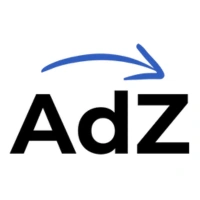Out-of-home (OOH) advertising has always been a high-impact channel. Billboards, transit ads, kiosks, digital screens — they all command attention because audiences can’t skip or scroll past them. But historically, OOH lacked precision. Brands relied on footfall estimates, demographic assumptions, and static creative. That’s where AI advertising is rewriting the rules.
Today’s OOH ecosystem is shifting from broad-stroke placements to hyper-intelligent outdoor targeting powered by machine learning, contextual data, and real-time optimisation. This evolution is not just a technological upgrade — it’s a new way of thinking about physical media.
AI Advertising: Why It Matters in Outdoor Environments
OOH has long been a trusted channel, but AI is enabling it to behave more like digital media — responsive, data-driven, and highly measurable. Modern DOOH networks integrate live data streams like mobility patterns, weather conditions, consumer behaviour signals and even time-of-day density to make intelligent placement decisions.
Recent industry analyses highlight that AI-powered DOOH sees significantly stronger engagement because of relevance and timing.
For marketers who want both brand visibility and performance, this combination is powerful.
Where Traditional Outdoor Targeting Falls Short
Despite being impactful, conventional OOH planning faces some limitations:
- Planners often depend on outdated traffic counts or generalised audience assumptions.
- Creative remains static even when outdoor conditions change.
- Measurement is vague — impressions, recall, estimated reach — not actual behavioural data.
- Budget optimization is slow because decision-making lacks real-time insights.
AI brings structure, intelligence and efficiency to each of these gaps.

How AI Improves Outdoor Targeting
1. Real-Time Data Modelling
AI gathers and interprets datasets such as:
- pedestrian movement
- vehicle flow
- seasonality indicators
- event-based triggers
- mobile footfall density
By analysing these continuously, AI suggests the best moment to activate specific creatives — making outdoor media behave dynamically.
2. Hyper-Accurate Audience Segmentation
Instead of relying only on demographics, AI identifies behavioural clusters — commuters vs shoppers, early-morning fitness crowd vs evening office returners, etc. This level of outdoor targeting brings unmatched precision and reduces budget waste.
3. Dynamic, Context-Aware Creative
With generative tech and automated creative optimisation, AI can change messaging depending on:
- weather (“It’s hot today, cool off with…”)
- live traffic
- time bands
- local cultural moments
- micro-audience presence
This makes even the same billboard feel alive and relevant.
4. Optimised Placement & Reduced Wastage
AI evaluates historical performance, cost-efficiency, heat-maps and even saturation levels to suggest locations that deliver more impact per rupee. For brands seeking ROAS-driven OOH, this is game-changing.
5. Advanced Measurement & Attribution
One of the previously missing pieces in OOH — attribution — is now possible. AI can connect:
- exposure → mobile activity
- exposure → store visits
- exposure → website interactions
- exposure → app-level conversion signals
This brings OOH closer to performance marketing while keeping its mass-reach strengths.
How Brands Are Already Using AI Advertising
Leading brands are applying AI in multiple ways:
- Running context-aware ads at airports and tech parks during peak travel times.
- Using mobility data to determine which screens get higher qualified visibility.
- Creating dozens of creative variations and letting AI auto-select the best performers.
- Linking OOH exposure with in-app activity to form a seamless omnichannel journey.
- Running programmatic DOOH campaigns that optimise continuously instead of once per quarter.
This is not the future — it’s already happening.
Benefits of AI-Driven Outdoor Targeting
- Higher engagement levels
- Better creative relevance
- Lower media wastage
- Improved cost-efficiency
- Faster optimisation cycles
- Measurable and attributable outcomes
- More personalised brand experiences in outdoor environments

What to Consider Before Implementing AI in OOH
- Ensure ethical and compliant use of mobility or behavioural data
- Balance automation with creative authenticity
- Choose partners that understand both outdoor planning and machine learning
- Prioritise attribution models that link offline exposure to digital action
Why Brands Need a Brand Tech AI Platform to Win
The real power of AI emerges when all channels — OOH, DOOH, In-App, and Transit — work together inside a unified ecosystem. This is exactly where a Brand Tech AI platform becomes invaluable.
AdzBasket brings all campaign layers into one AI-driven interface. Brands can:
- Discover ideal outdoor locations
- Run advertising using AI platform intelligence
- Activate OOH + In-App together
- Optimise creative variations
- Track performance in real-time
- Attribute conversions across offline and digital touchpoints
It transforms outdoor advertising from guesswork into precision marketing.
Whether a brand wants reach, performance, or both — the AdzBasket AI engine helps launch campaigns smarter, faster and more efficiently.


